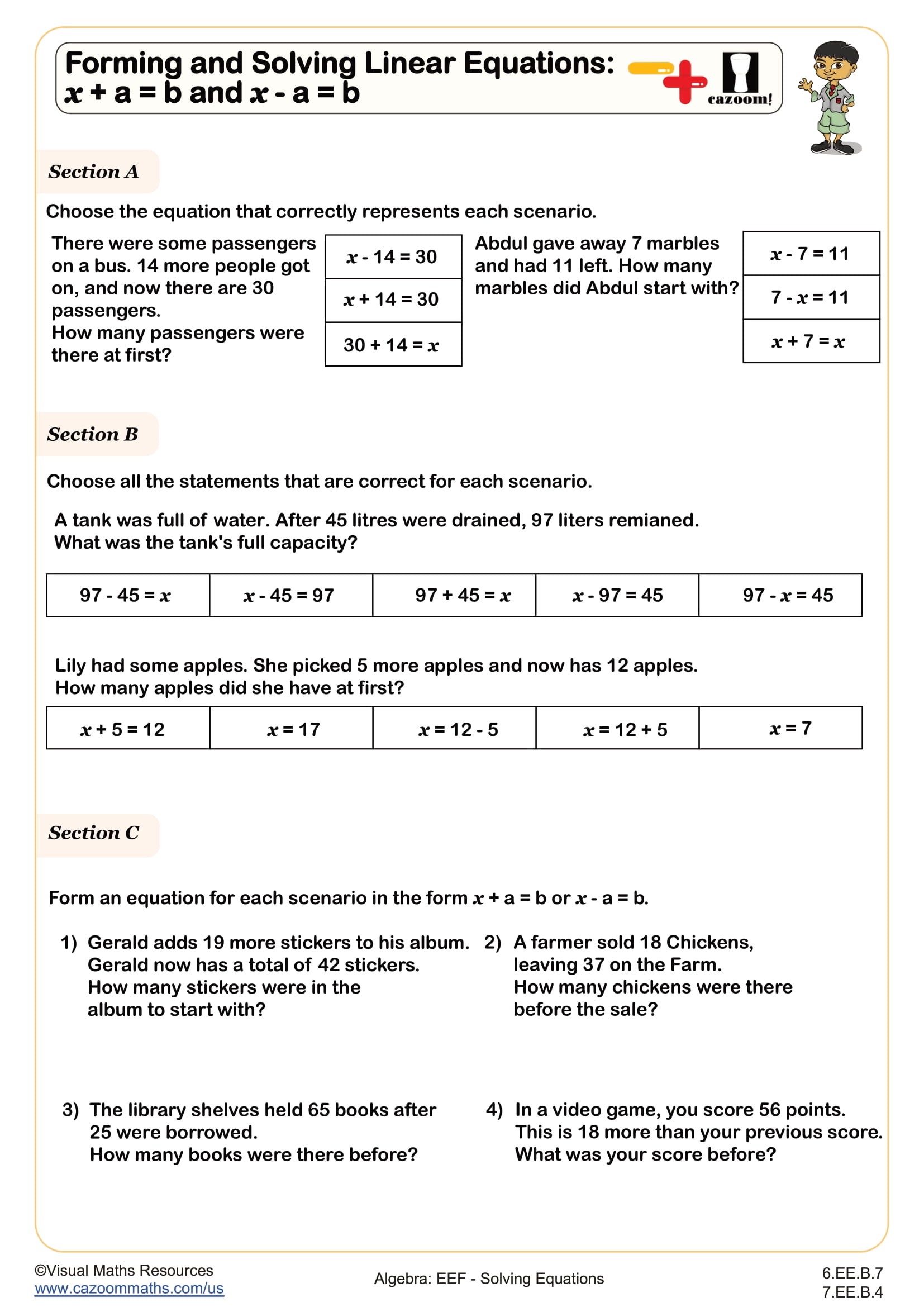Back to:
Forming and Solving Linear Equations: 𝑥 + a = b and 𝑥 - a = b WORKSHEET
Suitable for Grades: 6th Grade, 7th Grade
CCSS: 6.EE.B.7, 7.EE.B.4
CCSS Description: Solve real‑world and mathematical problems by writing and solving equations of the form x + p = q and p x = q for nonnegative rational numbers.
Use variables to represent quantities in a real-world or mathematical problem, and construct simple equations and inequalities to solve problems by reasoning about the quantities. a. Solve word problems leading to equations of the form px + q = r and p(x + q) = r, where p, q, and r are specific rational numbers. Solve equations of these forms fluently. Compare an algebraic solution to an arithmetic solution, identifying the sequence of the operations used in each approach. For example, the perimeter of a rectangle is 54 cm. Its length is 6 cm. What is its width? b. Solve word problems leading to inequalities of the form px + q > r or px + q < r, where p, q, and r are specific rational numbers. Graph the solution set of the inequality and interpret it in the context of the problem. For example: As a salesperson, you are paid $50 per week plus $3 per sale. This week you want your pay to be at least $100. Write an inequality for the number of sales you need to make, and describe the solutions.
Use variables to represent quantities in a real-world or mathematical problem, and construct simple equations and inequalities to solve problems by reasoning about the quantities. a. Solve word problems leading to equations of the form px + q = r and p(x + q) = r, where p, q, and r are specific rational numbers. Solve equations of these forms fluently. Compare an algebraic solution to an arithmetic solution, identifying the sequence of the operations used in each approach. For example, the perimeter of a rectangle is 54 cm. Its length is 6 cm. What is its width? b. Solve word problems leading to inequalities of the form px + q > r or px + q < r, where p, q, and r are specific rational numbers. Graph the solution set of the inequality and interpret it in the context of the problem. For example: As a salesperson, you are paid $50 per week plus $3 per sale. This week you want your pay to be at least $100. Write an inequality for the number of sales you need to make, and describe the solutions.
Forming and Solving Linear Equations: 𝑥 + a = b and 𝑥 - a = b WORKSHEET DESCRIPTION
This worksheet builds fluency in forming and solving simple linear equations of the forms x + a = b and 𝑥 − 𝑎 = 𝑏, using real-life contexts. Learners focus on interpreting the language in each scenario to decide whether it represents an addition or subtraction situation.
In Section A, learners are presented with two scenarios and must choose the correct equation that models each one. Section B follows a similar format, but this time they select all the equations that represent each scenario, including the steps taken to solve them and the final solutions.
In Section C, learners form equations for four scenarios based on everyday situations. Finally, Section D requires them to both form and solve equations for six additional scenarios, helping to consolidate their understanding through independent practice.
In Section A, learners are presented with two scenarios and must choose the correct equation that models each one. Section B follows a similar format, but this time they select all the equations that represent each scenario, including the steps taken to solve them and the final solutions.
In Section C, learners form equations for four scenarios based on everyday situations. Finally, Section D requires them to both form and solve equations for six additional scenarios, helping to consolidate their understanding through independent practice.



